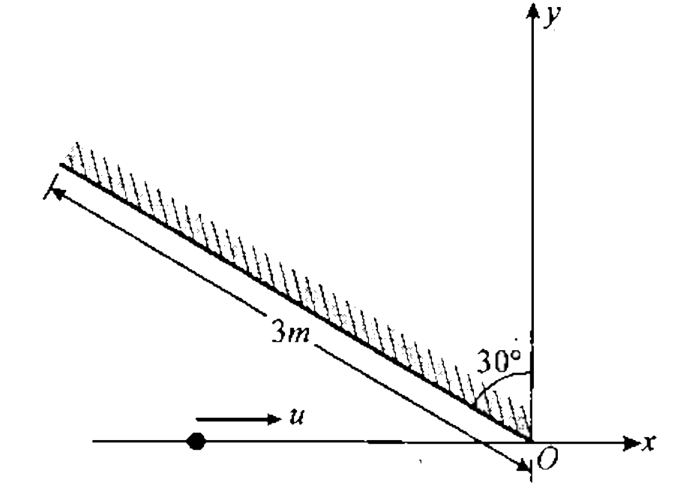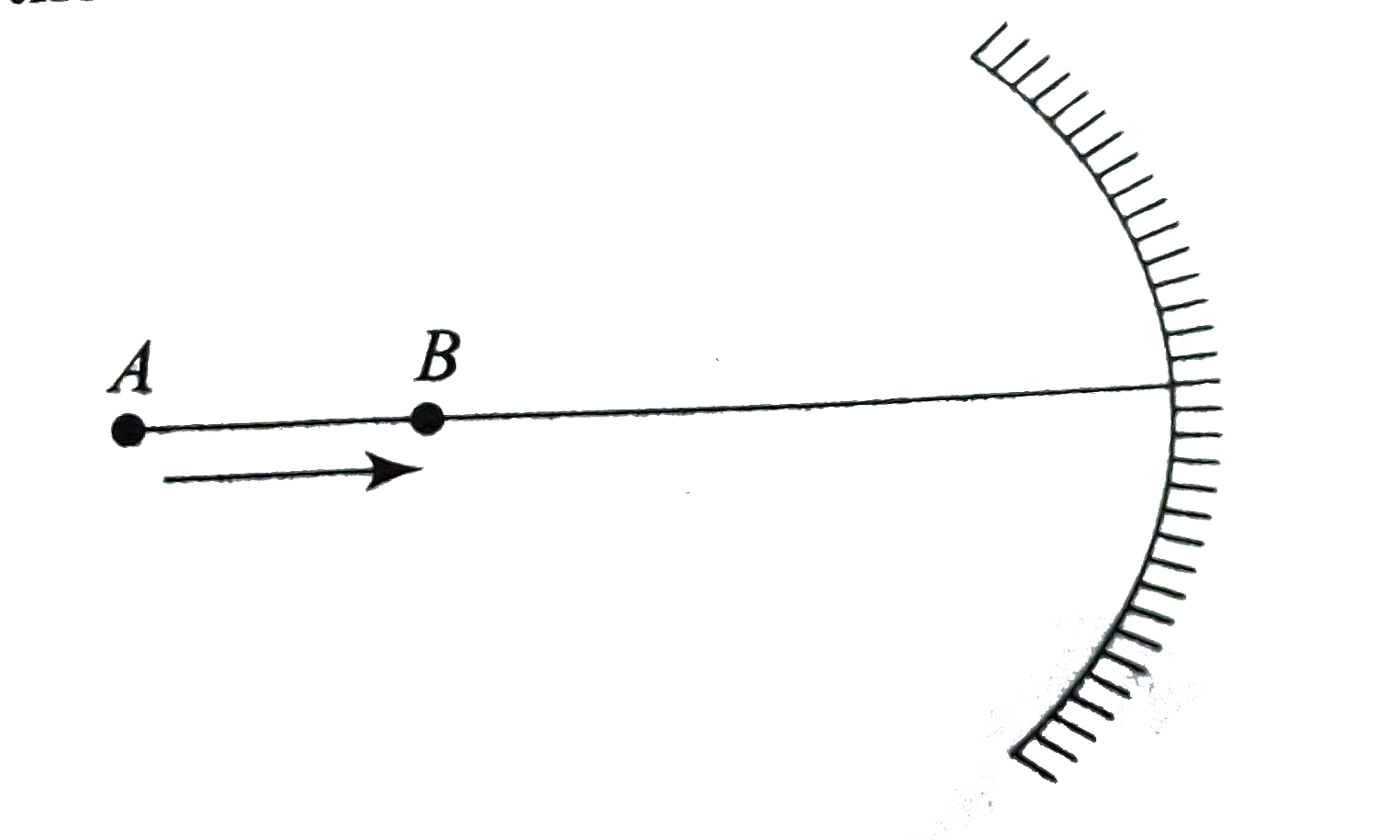A cubicla room is formed with 6 plane mirrors. An insect moves along the diagonal of the floor with uniform speed. The speed of its image in two adjacent walls is 20√2cm/s.
Then the speed of the image formed on the roof is
20cm/s
40 cm/s
20√2cm/s
10√2cm/s
The correct Answer is:B
To solve the problem, we need to analyze the movement of the insect and the formation of its image in the cubic room formed by mirrors.
1. Understanding the Setup:
- The insect is moving along the diagonal of the floor of a cubic room.
- The speed of the insect is denoted as V.
- The speed of the image of the insect in two adjacent walls is given as 20√2cm/s.
2. Components of Speed:
- Since the insect is moving along the diagonal, we can break down its speed into components along the axes of the cubic room.
- The diagonal of the floor can be represented in a 2D plane (let's say the x-y plane) where the insect moves from one corner of the room to the opposite corner.
3. Relating Image Speed to Insect Speed:
- The speed of the image formed on the adjacent walls can be expressed in terms of the speed of the insect.
- If the speed of the insect is V, then the speed of the image in the direction of each wall can be calculated using the relationship:
Speed of image=V⋅1√2
- This is because the diagonal movement creates equal components along both axes.
4. Setting Up the Equation:
- We know from the problem that the speed of the image in the two adjacent walls is 20√2cm/s:
V⋅1√2=20√2
5. Solving for V:
- To find V, we multiply both sides by √2:
V=20√2⋅√2
- Simplifying gives:
V=20⋅2=40cm/s
6. Finding the Speed of the Image on the Roof:
- The speed of the image formed on the roof will also be equal to the speed of the insect V, because the roof is parallel to the floor and the insect’s motion is uniform.
- Therefore, the speed of the image on the roof is also 40cm/s.
Final Answer:
The speed of the image formed on the roof is 40cm/s.
- The insect is moving along the diagonal of the floor of a cubic room.
- The speed of the insect is denoted as V.
- The speed of the image of the insect in two adjacent walls is given as 20√2cm/s.
- Since the insect is moving along the diagonal, we can break down its speed into components along the axes of the cubic room.
- The diagonal of the floor can be represented in a 2D plane (let's say the x-y plane) where the insect moves from one corner of the room to the opposite corner.
- The speed of the image formed on the adjacent walls can be expressed in terms of the speed of the insect.
- If the speed of the insect is V, then the speed of the image in the direction of each wall can be calculated using the relationship:
Speed of image=V⋅1√2
- This is because the diagonal movement creates equal components along both axes.
- We know from the problem that the speed of the image in the two adjacent walls is 20√2cm/s:
V⋅1√2=20√2
- To find V, we multiply both sides by √2:
V=20√2⋅√2
- Simplifying gives:
V=20⋅2=40cm/s
- The speed of the image formed on the roof will also be equal to the speed of the insect V, because the roof is parallel to the floor and the insect’s motion is uniform.
- Therefore, the speed of the image on the roof is also 40cm/s.
The speed of the image formed on the roof is 40cm/s.
Topper's Solved these Questions
- BOOK - FIITJEECHAPTER - PHYSICS PART-IIIEXERCISE - ASSIGNMENT SECTION-II SUBJECTIVE27videos
PHYSICS PART-III
- BOOK - FIITJEECHAPTER - PHYSICS PART-IIIEXERCISE - ASSIGNMENT SECTION-II MCQ (SINGLE CORRECT)47videos
PHYSICS PART-III
- BOOK - FIITJEECHAPTER - OPTICSEXERCISE - NUMERICAL BASED QUESTIONS2videos
OPTICS
- BOOK - FIITJEECHAPTER - PHYSICS PART2EXERCISE - Numerical Based Question Decimal Type6videos
PHYSICS PART2
Similar Questions
Establish relation between the speeds of object and image formed by a spherical mirror.
View SolutionA plane mirror is placed with its plane at an angle 30∘ with the y-axis. Plane of the mirror is perpendicular to the xy-plane and the length of the mirror is 3m. An insect moves along x-axis starting from a distant point, with speed 2 cm/s. The druation of the time for which the insect can see its shown image in the mirror is:
 View Solution
View Solution
Knowledge Check
- Question 1 - Select One
A room (cubical) is made of mirros. An insect is moving along the diagonal on the floor such that the velocity of image of insect on two adjacent wall mirrors is 10cmsec. The velocity of image of insect in ceiling mirror is
A10cmsecB20cmsecC10√2cmsecD10√2cmsec - Question 2 - Select One
An observer moves towards a plane mirror with a speed of 2 m/s . The speed of the image with respect to the observer is
A1m/sB2m/sC4m/sD8m/s - Question 3 - Select One
A person is in a room whose ceiling and two adjacent walls are mirrors. How many images are formed
A5B6C7D8
A linear object AB is placed along the axis of a concave mirror. This object is moving towards the mirror with speed U. The speed of the image of the point A is 4U and the speed of the image of B is alSO 4U btu in opposite direction. If the center of the line AB is at a distance L from the mirror then find out the length of the object.
 View Solution
View SolutionUniform speed of 2 cm diameter ball is 20cm/s in a viscous liquid. Then, the speed of 1 cm diameter ball in the same liquid is
View SolutionAn observer moves towards a plane mirror with a speed of 2msec. The speed of the image with respect to the observer is
View SolutionDaniel walks directly toward a plane mirror at a speed of 0.25ms. Determine the speed of the image relative to him.
View SolutionIn a 3 dimensional space, two particles are moving with uniform speeds of 6m/s and 8m/s along two arbitrary curves. The speed of one particle, as observed by other can be :
View Solution

